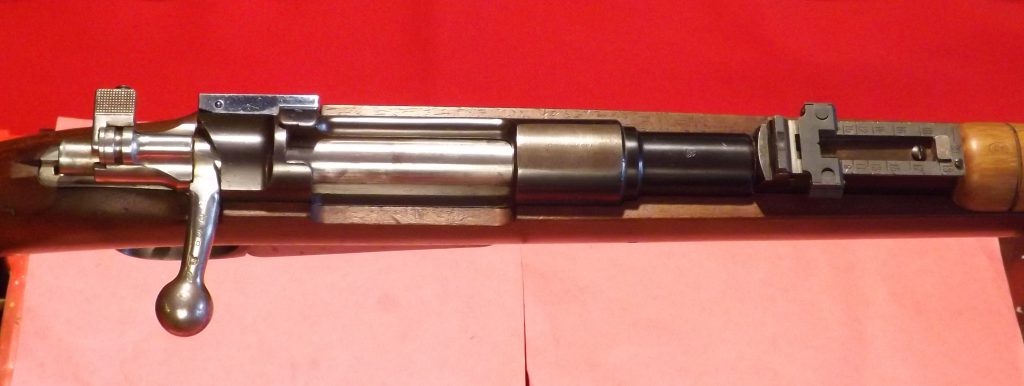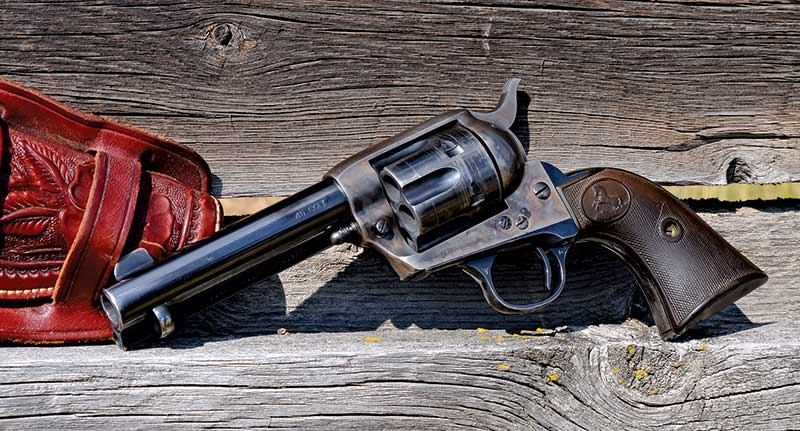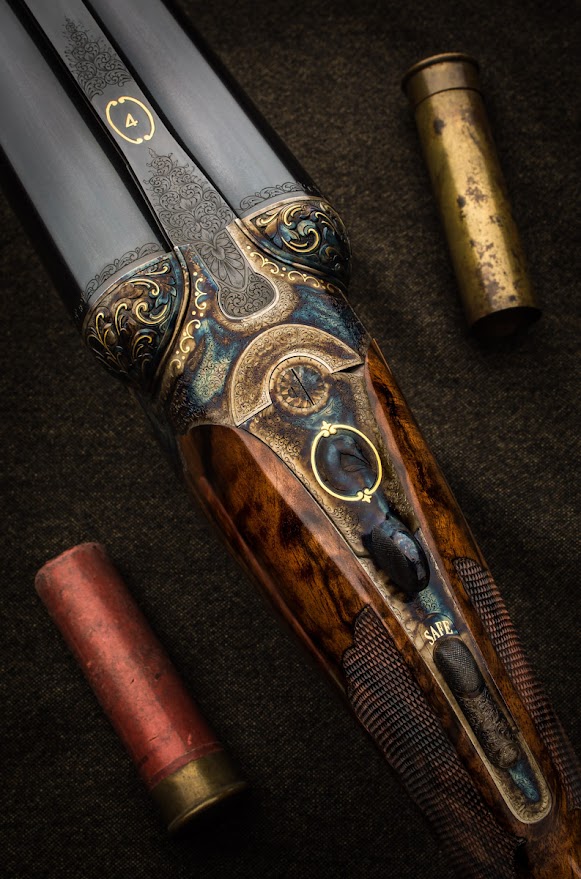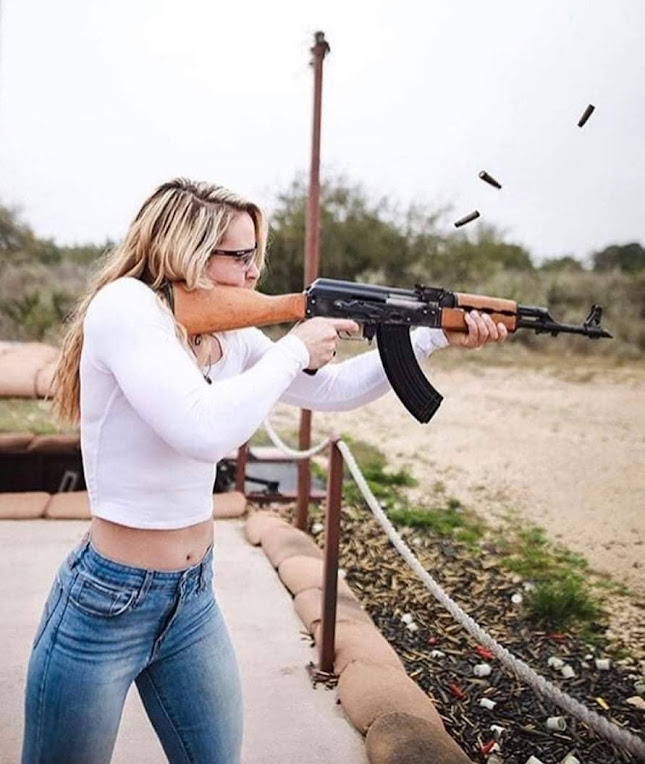This Mauser brothers issue has an action that first appeared in the Mauser Model 1889, a landmark in Mauser development because it was the first “small” caliber Mauser for smokeless powder and it introduced a bolt with dual, opposed locking lugs that became standard practice and is still with us today.
The bolt took its cartridges from a single stack, vertical magazine that could be charged from a stripper clip. A few changes were made when Argentina placed a large order for military rifles. The gun they got was the Mauser

Model 1891, often called the “7.65 Argentine” because it fired the 7.65 x 53 Mauser cartridge. What it looks like is shown in the picture. It is a typical military configuration for the time, a long stock with two bands, a ladder sight, and a straight bolt handle. The long magazine is an identifying feature.
An Argentine Sporter
Good bolt action sporting rifles were often made by converting surplus military rifles. I have always liked the looks of sporters based on the Model 1891. They are compact, have good lines, and look handy and effective. Some folks may not like the long magazine, but I do.
It blends with the trigger guard and is an identifying feature, not to mention that it holds five rounds of powerful 7.65 ammo. Then, when you see one up close, the level of craftsmanship is really impressive.

Sporter based on Model 1891 Mauser, the Argentine Mauser
The largest number of Argentines did not hit the shores of the USA until the waves of surplus militaries showed up in the 1950s and 1960s.
These waves included other Mauser models, including the Model 1898 German and the Model 1909 Argentine. These were the most advanced Mausers and the ones considered to be safest and best for conversion to a hunting rifle.

Receiver of 1891 Mauser
Nonetheless, the 1891 was popular for sporterization because it was an easy conversion. No rebarreling was necessary because the 7.65 x 53 cartridge was an excellent hunting cartridge that got the job done. Surplus military and factory rounds were both available.
The action was not strong enough for conversion to .30-06 or .270. Just cut and recrown the barrel, install a new front sight, shorten and reshape the stock and you were good to go after deer, bear, elk, whatever. A talented gun tinkerer could do the job (working patiently and carefully, of course). Gunsmith services for a scope base and trigger work would up the ante.
But none of this was really necessary in the heyday of surplus Argentines. Folks like Sears and Roebuck did the work and sold the product at a low price. I believe other merchandisers, say J. C. Penney and Woolworth’s did also. The gun in this article had that kind of origin.
My 1891 Argentine Sporter
OK, so you are not yet convinced. Stay with the program a while longer and take another

Front sight ramp
look at the sporter in the pic above. The barrel, keeping its chambering for the 7.62 x 53, has been shortened to 24 inches. The rear ladder sight was retained while a new front sight ramp was installed.
The original, military stock has been shortened appropriately and carries the military butt plate. The bolt has been bent down a bit. Receiver marking says it was made by Deutsche Waffen und Munitions Fabriken (DWM) in Berlin. The Argentine crest has been ground off the receiver ring and a tiny inscription “7.65 X 53” has been stamped on the top.

Receiver text. Note handshake icon on receiver ring and Phrygian cap icon on bolt release
The excellent condition makes me wonder whether the rifle was ever issued. Except for a few splotches of corrosion due to storage, the metal finish is very good. The wood, except for a few handling scratches, seems new.
The hand guard finish does not match the stock and is the only component that is not original to the rifle. A number of icons stamped in the wood, including a serial number, never saw a piece of sandpaper. The action shows no sign of any wear. Function is quite smooth.

Serial numbers of all parts, including the stock, are matching. They indicate manufacture in the year 1900. Earlier examples of the Argentine Mauser were made by Ludwig Loewe of Berlin.
Loewe was merged with an ammo company in 1896 and the combo became known as Deutsch Waffen und Munitions Fabrik. Argentines made after that time are marked with this ID, but some examples of the later 1909 Argy were manufactured in Argentina and are so marked.
When your piece says Loewe or DWM, you know you have the German quality. That applies to all 1891s.
There are several small icons that are stamped in the wood and metal of an Argentine Mauser. One is an image of hands clasped in a handshake. This is a symbol of unity and represents the unification of the provinces of Argentina.
Another small icon is best described as looking like the hat that the Smurfs wore. Remember them? It is called a Phrygian cap and its use goes back to antiquity.
During the French Revolution the wearing of a red Phygian cap was a sign of the quest for liberty. Argentina cherished its freedom as it was sometimes threatened by Chile and Brazil. I think these icons give the Argentine a sense of national identity.
Points of Interest in Design
The picture of the action removed from the stock illustrates functional simplicity, with some features that will still be found on sporting rifles. One such is a recoil lug made as part of the action frame beneath the receiver ring.
This lug has a threaded collar that engages the front receiver screw after it has passed through the front of the trigger guard. The receiver ring and bridge are relatively short and the rails are thick, giving an action that is stiff and

strong. The rear receiver screw passes through the rear of the trigger guard and threads into the tang behind the receiver bridge. The magazine construction is quite robust.
The magazine can be removed but is not meant to be removed in operation. Cartridges are pushed through the spring steel lips of the mag from the top. This works very well. The receiver bridge has a slot behind the mag to guide a stripper clip for battle use.
The one piece bolt features dual l locking lugs and a short hook extractor. Overall, the bolt resembles some much more modern bolts. The face is recessed for the cartridge rim and there is a slot for ejector travel in the left locking lug.
There is a cutout at the bottom of the face but it is not large enough to admit the case head. The action therefore operates as a push feed. At the end there is a bolt shroud with a three-position safety wing. The main spring of the striker is very strong, but there is a long travel and subsequent long lock time.

Argentine Mauser bolt
If you haven’t thought much of old military rifles you should find a nice Mauser and look inside the tree. Well, you don’t have to do that because I will give you a good look in the next picture.

Inletting of the walnut stock
The inletting of the wood and the fit of action to the wood is superb. Every feature of the action is supported. Note that there is a small metal wedge in the wood at the front of the recoil lug. This bears on the action screw socket and keeps the recoil lug snug against the wood at its rear face.
Other features are revealed by comparing the action photo with the inlet photo. Note that there is metal-to-metal contact between the recoil lug and the front screw guide of the bottom metal when the front screw is drawn tight to secure the metal to the stock .
Note also that there is a metal tube that guides the rear action screw and gives positive spacing between the rear tang and the bottom metal. The effect of these features is that the Argentine Mauser is pillar bedded as it comes to you.
Seeing this, I know that, despite being an addicted bedding freak, I will not touch the wood to metal arrangement until after I have done a lot of shooting with the piece. It should shoot quite well as is..
Ammo for the 7.65 x 53
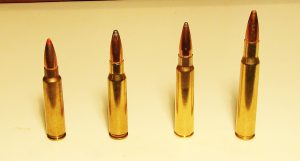
Cartridge comparison, L to R: .300 Savage; .308 Winchester; 7.65 Argentine; >30-06 Springfirld
There are four factory loads available. Two are made by Prvi Partizan Uzice (PPU) in Serbia. They have a full metal jacket, 174-grain load and a 180-grain soft point that would be suitable for hunting.
Both are available in the USA and are the least expensive factory loads for the Argentine. Norma loads a 174-grain soft point and it is expensive.
Most interesting to me is a 150-grain load sold by Graf & Sons and boxed under their name. The box says that the ammo is made under contract with Hornady. The brass has a PPU headstamp but I suppose the bullet is a Hornady number. This is the only 150-grain load available.

7.65 ammo from Graf & Sons (Hornady) and PPU
The 7.65 Argentine Sporter with Factory Ammo
To make the rifle a bit friendlier for my old eyes I enlarged the V-notch of the rear sight with a triangular file. This makes it a little easier to float the front bead in the rear notch and to center the bead in the circular target that I like to use.
It also helped to use an aperture on my glasses to increase depth of field in the axis of sight alignment. I fired three-shot groups at fifty yards. Feeding, extraction, and ejection were perfect.
Velocities given by the three factory loads I tried were PPU 174 gr, 2462 fps; PPU 180 gr, 2413 fps; Graf/Hornady 150 gr, 2723 fps. The thing to note here is the zippiness of the Hornady 150-gr load.
I feel that Hornady must be using a Hodgdon Superformance powder to get that kind of velocity at 7.65 Mauser pressure. No question that this load is in the same league as a .308 and would knock a deer into next week.
Group size was uniform and fell in the range of 1.0 – 1.5 inches. One group of 0.6 in was obtained with the Graf 150 gr load. That brought a smile to my face and a motivation to continue working with this gun.
Bench testing worked OK but the steel butt plate gives the shoulder a real thump – painful if the butt is not well placed.
Measurement with a Stony Point headspace gauge showed that firing moved the case shoulder forward a distance of 0.006 inch, so headspace seems OK.
Possibilities for Handloading the 7.65 x 53
Loading dies for the 7.65 x 53 are available from the usual makers of loading equipment. I bought a set from Lyman and the dies have worked fine. Loading technique is the same as would be used for any other rimless, shouldered cartridge.
No special tricks or tips required, but you must remember that bullets must be 0.312” in diameter. Since that is what the .303 British takes, there is a good choice of bullets available.
Several of the modern loading handbooks, Hornady’s, for instance, include loads for the 7.65 Argentine. The Model 1891 is not weak, but I think it best to stay with modest to moderate loads.
Such loads are easier on the shoulder and have the best chance of exhibiting fine accuracy. For hunting, the Argentine is safe with heavier loads, as the results with the aforementioned Graf/Hornady show.
For general shooting pleasure, I think I will seek a load that performs at the .30-30 level. The Hornady Manual says that 36 gr. of IMR 3031 will kick out a 150-gr. Bullet at about 2400 fps. Thinking ball powder, W748 should work well.
Collecting, Anyone?
I have had my eye on ads for used guns and their prices for many years. The days of low-priced, surplus military rifles of quality are long over. There are many of these bangers, however, and they do turn over as collectors get interested in something else or go to their reward.
If you stay vigilant and knowledgeable a good buy can come your way. That said, the cost of historically important military rifles has increased significantly in the last few years. That would include examples of the Krag/Jorgensen, the 1903 Springfield, the M1 Garand, and of course, the Mauser.
Mausers were never used by the American Military (although the 1903 Springfield is a really good copy of the 1898 Mauser).
However the role played by Mausers in the technical development of bolt action, military arms should make them attractive to all arms enthusiasts. These developments would be well illustrated by perhaps a half dozen rifles from the late 19th century.
And the cost would be way, way less than a similar assemblage of Colt revolvers or Winchester rifles. Cost, of course, is affected by the condition of the individual arms, pristine examples bringing many times the price of rough examples or rifles that have been modified in some way.
So, “serious” collectors would scoff at my barrel bobbed ’91 Argentine Mauser. I will only say that it has matching numbers, is in excellent condition, functions as it should, shoots very well, and fully illustrates Mauser design of its time.
It is a part of American sporting history as well as of the history of military arms design. I enjoy owning it and shooting it, and that is not likely to change.
